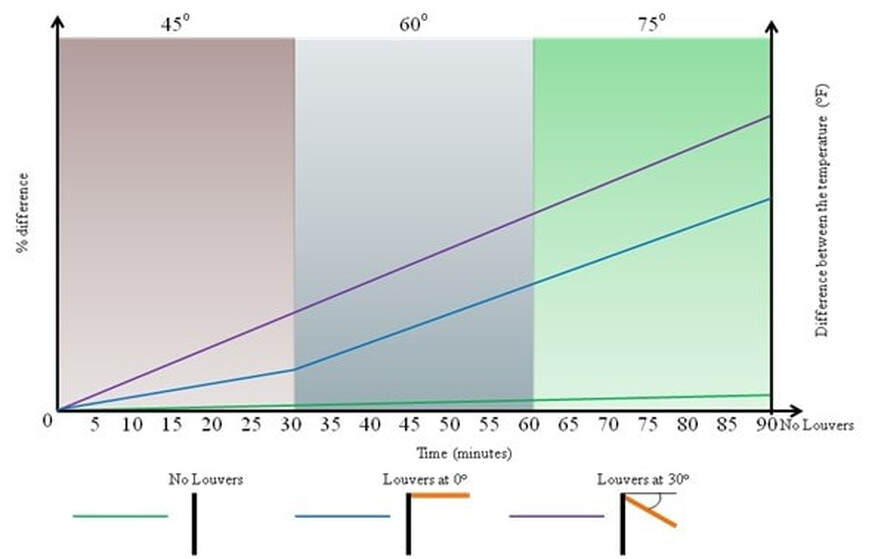Expected Results
Discussion
When the experiment is carried out without the louvres in all the 3 cases i.e. lamp is placed at 45o, 60o and 75o, the radiation from the lamp directly falls on the acrylic sheet. The acrylic sheet is heated and the internal temperature also rises. Thus, there is very less or negligible difference between the outside and the inside temperature.
When the louvres are fit at 0o, it is quite possible that when the lamp is placed at 45o, the radiation might directly fall on the acrylic sheet. Thus increasing the internal temperature. As the lamp is moved further to 60o and 75o, this direct radiation is obstructed by the louvres and further radiation is blocked by the louvres. Thus the internal temperature might remain the same or reduce. But, the outside temperature is still rising. As a result, the temperature difference between outside and inside of the box increases.
When the louvres are placed at 30o, the radiation from lamp is totally obstructed for all the angles (45o, 60o and 75o) of the lamp. Thus, no direct radiation is falling on acrylic sheet and no heating of sheet take place. Thus internal temperature remains constant or might increase in negligible quantity, while the outdoor temperature is still rising further with time. Thus, the temperature difference between outside and inside is increasing continuously.
When the louvres are fit at 0o, it is quite possible that when the lamp is placed at 45o, the radiation might directly fall on the acrylic sheet. Thus increasing the internal temperature. As the lamp is moved further to 60o and 75o, this direct radiation is obstructed by the louvres and further radiation is blocked by the louvres. Thus the internal temperature might remain the same or reduce. But, the outside temperature is still rising. As a result, the temperature difference between outside and inside of the box increases.
When the louvres are placed at 30o, the radiation from lamp is totally obstructed for all the angles (45o, 60o and 75o) of the lamp. Thus, no direct radiation is falling on acrylic sheet and no heating of sheet take place. Thus internal temperature remains constant or might increase in negligible quantity, while the outdoor temperature is still rising further with time. Thus, the temperature difference between outside and inside is increasing continuously.
Conclusion
Due to modernization, there is a trend of using glazing for facade. When sun radiation fall on the glass facade, it get heated. This heat is trapped inside the building causing the greenhouse effect. This heat rises the internal temperature, and demanding more energy for cooling. Shading the glass with louvers will help avoid the direct radiation from the sun. Thus, the internal temperature will remain cooler compared to the internal temperature without the louvers. It can be concluded from the experiment that the attaching louvers to the glass facade will help reduced internal temperature by preventing direct radiation from the sun falling on glass. This experiment could be conducted to know how much the temperature difference is achieved with the louvers. We can also know what angle is perfect for louvers to achieve thermal comfort. It can reduce the cooling demand, thus by saving energy and its cost. In very hotter climate, it might not eliminate the air conditioning demand, but it could reduce the energy required to achieve thermal comfort. While in moderate climate area, it is quite possible to totally get rid of air conditioning. Just a ventilation will be useful to achieve thermal. Thus, energy required to cool the internal environment to achieve thermal comfort will be completely nil.
